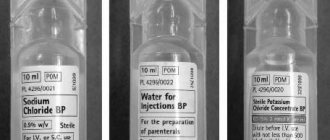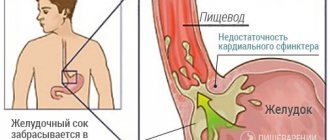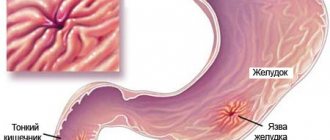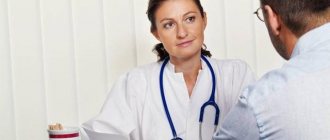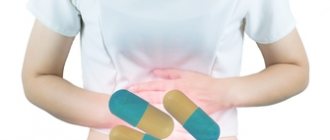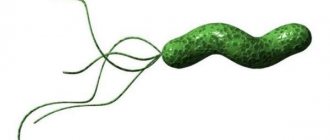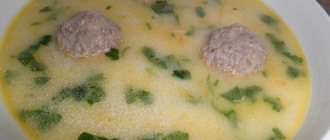Structure of the rectum
The rectum is the final section of the intestine, it begins in the sigmoid colon and ends in the anus. The lining of the rectum is made up of muscle and has a large amount of mucus, which helps push down leftover food.
Two muscle rings (anal sphincters) contract and retain feces. And during their relaxation, defecation occurs. In men, the rectum is connected to the prostate and bladder, in women - to the vagina and uterus.
When the rectum functions properly, all processes go unnoticed, but if there is any malfunction, inflammation of the rectum can develop. More than 30% of people with inflammatory bowel disease have inflammation of the rectum. One of the most common diseases is proctitis.
Diagnosis of the disease
The disease can be identified after contacting a proctologist and conducting clinical studies.
Often, diagnosis is performed in cases where the patient has an acute or chronic form of inflammation of the rectum. Types of diagnostic studies:
- Manual rectal analysis . The proctologist puts sterile gloves on his hands, after which his index finger penetrates the patient’s anus to assess the functioning of the sphincter, mucous membrane and walls of the rectum, as well as neighboring organs. In addition, the doctor examines the discharge from the anus. Rectal analysis causes discomfort for the patient, so it must be performed by a specialist carefully and quickly.
- Rectoscopy . The execution method is almost the same as the previous method. The only difference is the use of a rectoscope - a special instrument in the form of a metal tube with a microcamera. Compared to rectal analysis, which is performed manually, rectoscopy has more advantages because the proctologist can examine the walls of the rectum and sigmoid colon. For small patients, the proctoscope is inserted under anesthesia.
- Biopsy of the rectal mucosa . A proctologist examines the material obtained as a result of rectoscopy under a microscope. It is a very effective diagnostic method.
- Stool analysis . Allows you to determine the presence of blood in feces and identify pathogenic bacteria.
Proctitis, its types
Proctitis can be acute or chronic.
Acute proctitis has permanent symptoms that appear in a person for a short time. Inflammation of the rectum in acute form is accompanied by fever, general weakness, and malaise. It can be caused by acute infectious diseases and rectal injuries.
Types of acute proctitis:
Catarrhal proctitis
Catarrhal proctitis is the first stage of inflammation of the rectum in its acute form. It is characterized by pain in the abdomen and anus, and the appearance of droplets of blood on toilet paper after defecation.
Catarrhal proctitis can be divided into:
- catarrhal-hemorrhagic proctitis (the rectal mucosa is red, swollen, and has a large number of hemorrhages);
- catarrhal-purulent proctitis (pus appears on the rectal mucosa);
- catarrhal mucous proctitis (swelling, inflammation of the rectum accompanied by the appearance of a large amount of mucus).
Polypous proctitis
With polypous proctitis, small seals resembling polyps grow on the rectal mucosa.
Erosive proctitis
Erosive proctitis is characterized by the formation of erosion on the mucous membrane. Ulcerative proctitis is a type of erosive proctitis, when ulcers begin to open on the mucous membrane of the rectum. There are ulcerative-necrotic and purulent-fibrous proctitis.
Radiation proctitis
Radiation proctitis appears at the end of radiation therapy. It is characterized by attacks of acute pain, stool is accompanied by pus and blood, ulcers form on the rectum, a fistula or even lymphostasis may open, which, growing, can close the space in the rectum.
Chronic proctitis
Symptoms of proctitis in chronic form are not as intense, but can bother you for a long time. Cycles of exacerbation and remission are periodically repeated. This type of inflammation of the rectum is caused by chronic infections, autoimmune diseases, malignant tumors of the rectum, and vascular pathology.
Chronic proctitis is divided into:
- atrophic proctitis (thinning of the rectal mucosa);
- hypertrophic proctitis (thickening and loosening of the mucous membrane).
Erosive proctitis
Acute stage of the disease
With erosive proctitis, symptoms appear as superficial erosions (defects, flaws) on the tissues and mucous membrane of the rectum. Gradually they heal and do not leave scars, becoming covered with a crust and subsequently falling off. This form of the disease can be provoked by nonspecific infectious agents (simple streptococci, staphylococci) that provoke various types of inflammatory purulent processes.
In form, depending on the provoking factors, erosive proctitis occurs as: radiation, immune, somatic, stagnant, traumatic, alimentary.
In patients, feces begin to stagnate in the rectal passage, compress the venous vessels, and impair the outflow of venous blood in the walls of the large intestine.
The chronic form of erosive ulcerative sphincteritis develops after:
- carrying out diagnostic procedures;
- masturbation, anal sex;
- effects of radiation therapy;
- chemical trauma to the rectal mucosa;
- introducing aggressive substances by mistake or purposefully (with a criminal connotation), for example, to punish a person during interrogation.
A thermal cause of the development of erosive ulcerative proctitis is possible in the case of accidental (intentional) introduction of a hot or cold solution into the rectum, location of the perineum on a hot surface, contact of patients with radiation sources or radioactive substances with unauthorized access to them, for example, during combat operations.
Symptoms of erosive proctitis are acute, sudden:
- fever, chills;
- burning, itching, pain in the anus;
- violation of the act of defecation;
- feeling of heaviness, a foreign object in the anus;
- general deterioration of health;
- discharge of liquid feces with impurities of mucus, blood, pus;
- characteristic pain, frequent tenesmus.
Note! A feature of erosive proctitis is the formation of multiple defects on the surface of the rectal mucosa. Most often, pathology develops after contact gamma therapy or other radiography methods.
Symptoms of proctitis
All symptoms of rectal inflammation can be divided into local signs of rectal inflammation and general ones (reaction of the whole body to inflammation).
Local symptoms of rectal inflammation:
- discomfort, feeling of fullness in the rectum;
- constant desire to defecate;
- anal itching and pain in the rectal area, worsening with bowel movements;
- pain in the left side of the abdomen, cramps;
- mucous and purulent discharge from the anus, which may contain blood;
- pain in the perineum, radiating to the lower back and genitals;
- diarrhea or constipation;
- fecal incontinence (see sphincter incontinence).
General symptoms of proctitis may be as follows:
- increased body temperature;
- anemia, weakness, loss of strength;
- sudden weight loss;
- loss of appetite;
- joint pain;
- skin rash;
- inflammation, redness of the eyes, tearing;
- depression or frequent mood swings.
Signs of acute proctitis
From the effects of radiation on the colon, there is a disruption of the normal division and maturation of cells, their peeling, atrophy, and covering with scales.
In acute proctitis, symptoms begin to appear at an early stage:
- periodic painful urge to empty the intestines;
- paroxysmal pain that gets worse after going to the toilet
- effusion of blood, pus and anus;
- burning, itching, presence of a foreign object in the anal canal.
Additional symptoms of inflammation of the rectal mucosa:
Manifestations of the disease
- physical weakness;
- high temperature up to 38 degrees;
- chills with purulent-ulcerative proctitis.
Usually after 3-4 days, acute symptoms begin to subside. Especially if patients are undergoing treatment taking antibiotics and anti-inflammatory drugs. But after a certain time, symptoms can flare up again, as if delayed, 3-4 months after exposure to radiation. Frequent urination, passing feces in small portions, pain in the anus, dull pain in the left iliac region (in the rectal area) begins to bother me.
Reference! An obvious sign of radiation proctitis is the passage of stool with mucus. The manifestation of early symptoms cannot be ignored: false urges during bowel movements, paroxysmal intense pain after emptying the intestines and the release of feces, constant secretion of mucus, burning, itching in the anus with intensification after bowel movement, a pulling urge to defecate with pain radiating to the abdominal muscles, rectal bleeding, unusual mucus discharge, weight loss.
Causes of proctitis
The causes of proctitis can be very diverse:
- Crohn's disease or ulcerative colitis;
- non-inflammatory diseases of the rectum (hemorrhoids);
- infectious causes (presence of streptococcal infection, protozoan parasites, viruses);
- infectious sexually transmitted disease (gonorrhea, chlamydia, syphilis and other STDs);
- tuberculosis disease;
- chronic constipation;
- poor nutrition;
- long-term use of certain medications, especially antibiotics;
- food allergies;
- damage to the rectum (for example, due to a foreign body in the intestine);
- side effect of radiation treatment for some forms of cancer.
Treatment of chronic proctitis
Doctor for delicate problems
The chronic form is characterized by a sluggish course, so treatment is a course. For radiation proctitis, patients are prescribed supportive treatment with long-term medication to relieve inflammation and strengthen the immune system.
When treating radiation proctitis, it is recommended to use candles, sign up for a massage and radon baths. Physiotherapy methods have proven themselves well: exercise therapy, mud therapy, balneotherapy, stay in a sanatorium. Also enemas for proctitis with the introduction of decoctions, herbal infusions (oregano, lemon balm, chamomile, calendula).
Reference! If you treat ulcerative proctitis in a timely manner, reduce the frequency of exacerbations, adhere to a healthy lifestyle and a special diet, you can achieve stable remission even after treatment of chronic proctitis or diagnosis of oncology.
Treatment of proctitis
To prescribe the correct treatment for inflammation of the rectum, you need to conduct a complete examination of the human body. The diagnosis is established on the basis of all data, including digital examination of the rectum, examination of the intestine using proctoscopy, colonoscopy, biopsy of the intestinal wall, and stool culture.
The method of treating proctitis is determined by the nature of the disease, its severity, the presence of symptoms, the development of complications, etc. Some patients require short-term treatment for rectal inflammation, while others require long-term treatment and medical supervision.
Drug treatment of proctitis
Any treatment for inflammation of the rectum should be selected individually by a doctor; self-medication is unacceptable!
Prevention of violation
In order not to treat inflammation of the rectum and dangerous complications, it is worth taking preventive measures.
To do this, it is necessary to promptly consult a doctor if diseases of the gastrointestinal tract and inflammatory processes in adjacent organs appear.
In your diet, you should limit your intake of spicy, fatty and fried foods. It is recommended to completely give up alcoholic beverages and smoking.
It is important to take care of genital hygiene and protection during sexual intercourse.
Features of the structure and function of the rectum
The rectum is the final segment of the intestine, ending at the anus.
The primary function of this organ is to remove waste products from the human body. This can be achieved thanks to the special structure of the rectal wall.
The length of the rectum is 13-15 cm. This section is represented by:
- mucous membrane;
- submucosal layer;
- muscular layer.
Thanks to the significant muscle layer, dense feces are pushed towards the anus. The mucous membrane produces a sufficient volume of mucus, which ensures the unhindered movement of feces.
The process of defecation is controlled by two sphincters - internal and external, represented by rings of muscles. When they contract, feces are retained in the intestines; if they are relaxed, feces are released. This becomes possible due to the fact that the mucous membrane has a huge number of nerve endings.
Research methods
To identify the disease, both laboratory and instrumental research methods are used. Diagnosis begins with examining the patient and analyzing his symptoms. A connection between proctitis and radiation is always found.
A general blood test reflects signs of the presence of an inflammatory process - leukocytosis, an increase in ESR, a shift of the formula to the left. This method helps assess the severity of the disease, but cannot be used to make a final diagnosis.
The most informative method of examination is sigmoidoscopy. When examining the walls of the rectum, the following is found:
- hyperemia;
- swelling of the mucous membranes;
- the presence of blood and mucus in the lumen.
In addition, this method allows you to determine the presence of complications such as strictures, ulcers, abscesses and perforation of the organ wall. Erosions are most often found on the anterior part of the intestine, in some cases they lead to the formation of fistulas. The examination should be combined with a biopsy of the mucous membranes.
Histological examination helps to assess the severity of pathological changes in tissues. To identify the causative agent of infection, a bacteriological analysis of a smear from the anus is performed.
Since the disease is defined by the same symptoms as ulcerative colitis, it is necessary to be able to distinguish between these pathologies. The former is supported by previous radiation therapy and the presence of ulcerative defects in the anterior part of the rectum. In colitis, pathological changes are widespread; they affect all mucous membranes of the organ.
Rectal mucosa, structure, features of functioning
The rectal mucosa is covered by columnar epithelium, which is equipped with a large number of bacilli cells. It also contains quite a lot of liberkühn glands, which are almost entirely formed by mucous cells. This can explain the fact that in the case of the development of pathologies of various types, abundant mucous discharge is observed from the rectum.
Just above the anus there is a series of vertical formations. These elevations are called the columns of Morgagni. They look like longitudinal rollers. They are formed by a fold of the mucous membrane and rise 2-4 cm above the mucous membrane itself. Indentations are formed between the columns, at the end of which there are blind pockets. They can often retain particles of feces and foreign bodies, which subsequently provoke the development of inflammatory processes.
The composition of rectal mucus has enzyme components that contribute to the partial processing of nutrients. Everything that is not processed is formed into feces and excreted from the body.
Signs of manifestation
The insidiousness of the inflammatory process in the rectum lies in the absence of symptoms and signs at the initial stage of the disease. It is still possible to determine the development of the inflammatory process. Pain, as well as other symptoms, almost always accompany the inflammatory process, but it is especially intensified during defecation. In acute cases, it is acute in nature, and in chronic proctitis it is aching in nature. Discomfort, burning, itching occurs, which is more pronounced in the acute form and is practically unnoticeable when the disease becomes chronic. The discomfort from the polyp located in the intestinal cavity increases.
In addition, the patient experiences a number of symptoms characteristic of such a disorder:
- general malaise;
- chills and fever;
- muscle weakness;
- pain in the perineum and lower back;
- rectal discharge;
- stool disorders;
- symptoms of indigestion;
- painful urge and frequent bowel movements;
- discomfort due to a tumor or polyp;
- bloody and purulent inclusions.
With chronic proctitis, pale skin, symptoms of anemia and exhaustion are observed.
Common diseases of the rectal mucosa
Due to completely different reasons, pathological changes in the rectal mucosa may occur. The most common ones include the following:
1. Inflammation of the rectal mucosa
There are many root causes for the development of such a disease, another name for which is proctitis.
- Nutritional imbalance;
- development of constipation, hemorrhoids and other diseases of the rectum;
- diseases of organs located in the pelvis;
- complications after sexually transmitted diseases;
- presence of parasites.
The patient can judge the presence of inflammation of the rectal mucosa by a number of signs. First of all, this is a feeling of pain in the corresponding area, which only intensifies at the time of defecation. Along with the feces, you may notice discharge with blood or pus. The patient complains of worsening general condition and increased body temperature. Due to pain in the perineum and anus, motor functions are limited.
Important! Having discovered similar symptoms, it is very important to consult a doctor in a timely manner to clarify the diagnosis, since rectal cancer also has similar symptoms, and it can be successfully treated only in the early stages.
Inflammatory hyperplasia of the rectal mucosa can lead to the formation of pseudoadenomatous polyps.
Treatment of inflammation is prescribed only after the diagnosis is confirmed. To exclude other diseases, diagnosis is needed. The best solution is to approach the problem in a comprehensive manner. First of all, the patient needs to follow a strict diet.
All foods that irritate the mucous membranes should be excluded (spicy, fatty, meat). Mud therapy, therapeutic baths, therapeutic exercises are also quite effective methods. If the form of the disease is more serious, then drug treatment cannot be avoided, and sometimes surgery is necessary.
Mucosal prolapse
Prolapse of the walls of the rectum most often occurs as a result of previous abnormalities in the pelvic area, chronic constipation, age-related changes in the anal muscles, and in women it can be the result of difficult childbirth.
Eliminating such a problem comes down to setting the fallen part back. If this is not done, inflammatory changes and erosions may develop. If the prolapsed mucosa is pinched, necrosis may occur.
Anal fissure
Patients who are susceptible to such a pathology as micro-tear of the mucous membrane, which is the result of injuries and periodic constipation, have to deal with a similar disease. The main signs of this disease are acute pain and bleeding. Modern medicine has a whole arsenal of methods for treating this disease. They allow you to eliminate the disease without surgery. The main thing is to consult a doctor in time so that the unresolved problem does not turn into a rupture of the rectum.
Nutrition for inflammation of the rectum
One of the main aspects in the treatment of proctitis is diet. After all, it is very important, during this difficult period for the intestines, to relieve it as much as possible and at the same time provide it with food that will help in the treatment of the disease.
First of all, you need to give up bad habits such as alcohol and smoking. Alcohol is a strong irritant to mucous membranes. In turn, tobacco smoke, entering the intestines, not only tends to destroy the epithelium, but can also lead to more serious diseases such as cancer. And if such aggressive substances get on an already affected area of the rectal mucosa, then this can significantly aggravate the problem.
Strict adherence to the diet will help make treatment more effective. It is necessary to exclude:
- spicy
- sour
- sweet
- fried foods
- limit the use of various spices.
You also need to temporarily remove fruits and cereals , because they are rich in fiber, and in this case it can damage the inflamed mucous membranes of the rectum.
Nutritionists recommend paying special attention to fermented milk products , such as kefir and low-fat cottage cheese, as well as fermented baked milk and homemade yogurt. These products:
- do not irritate mucous membranes
- I normalize the microflora in the intestines
- promotes soft stools
Gradually you need to introduce steamed, boiled lean meat into your diet: beef, rabbit, veal. You can prepare light vegetable soups. Vegetables and fruits should also only be consumed steamed. Baked apples will be very useful in this case .
If the disease is accompanied by constipation, you should not independently select products that have a laxative effect; it is better to consult a doctor. Most of them only contribute to irritation of the mucous membrane and cause inflammation again.
Inflammation of the rectum is an extremely unpleasant disease. But if you carry out timely treatment, then there will be no trace of the disease. Be healthy!
Prevention of diseases of the rectal mucosa
Preventive measures will help to avoid pathologies of various types in the rectal region.
- First, you need to pay special attention to your diet. Monitor the amount of fluid you drink daily and the presence of dietary fiber of plant origin in your diet. Do not get carried away with flour and dairy products.
- It makes sense to practice bowel hygiene. During bowel movements, try not to overload. After the emptying process, try to use a wet napkin rather than dry toilet paper.
- Pay close attention to your health.
- Monitor the normalization of physical activity.
This is especially true for those people whose work involves a sedentary lifestyle. In such situations, it is necessary to take 5-10 minute breaks after every hour of “sitting”, during which you can simply walk around or do simple exercises.
If any failures or malfunctions are detected, it is advisable not to delay going to the doctor and, even worse, not to ignore the symptoms, but to take the necessary measures in a timely manner. Only under this condition will it be possible to prevent serious complications, and in some cases, save your life.
Work experience more than 7 years.
Professional skills: diagnosis and treatment of diseases of the gastrointestinal tract and biliary system.
Inflammation of the anus can occur at any age. Men and women are equally susceptible to the disease. The reasons are varied - from basic non-compliance with hygiene rules to complex gastrointestinal diseases. Symptoms appear individually in each case, but there are common characteristic features.
How to treat proctitis at home?
Drug treatment of proctitis is divided into general and local. For inflammation of the rectal mucosa, antibiotics are prescribed in tablets and injections (in case of infectious, gonococcal nature of the disease and the presence of other diseases of the digestive system.
Local treatment (suppositories for inflammation and painkillers, microenemas) help relieve symptoms and restore the mucous membrane.
Medicines
You should not choose medications for the treatment of proctitis on your own. This should be done by a doctor, taking into account the exact cause, the nature of the disease and the presence of concomitant pathologies.
For example, uncontrolled use of antibiotics can increase dysbiosis in the intestines. As a result, inflammation in the rectum will also intensify.
Another article on this topic: Trimedat - instructions for use, price, reviews
| Group of drugs | Action | Drug names |
| Antibiotics | They kill pathogenic flora and inhibit their reproduction. Act throughout the entire digestive tract. For treatment, those drugs are selected that reach the rectum unchanged. | Phthalazol, Neomycin, Kolimycin |
| Anti-inflammatory | Remove swelling and itching, relieve inflammation, stimulate regenerative processes | Proctosan, Ultra-Proct, Relief-Ultra, suppositories with prednisolone |
| Medicines that relieve pain | Local anesthetic agents - suppositories and ointments that relieve pain, facilitate the process of defecation, envelop the mucous membrane and prevent the appearance of new damage. | Belladonna suppositories, Anestezol |
Treatment with folk remedies
Proctitis cannot be cured using alternative medicine alone. They should be used in parallel with the main treatment to speed up the process.
Most often used:
- Herbal decoctions. I drink them on an empty stomach, half an hour before meals. This can be a decoction of one plant or complex mixtures based on string, chamomile, plantain, nettle, and dandelion. Dry raw materials are taken in equal proportions, then poured with boiling water in a ratio of 1 glass per tablespoon of herbs and infused. Every day you need to prepare a new decoction. These remedies are quite effective, but do not act instantly, so the course lasts from 2 to 4 weeks.
- Microclysters . For this purpose, use the same decoction as for oral administration, or a small amount of oil. Sea buckthorn has a healing agent. Microclysters should be done after a natural bowel movement, and should be retained for several hours. To relieve constipation and severe pain when passing stool through the anal sphincter, a small amount of oil can be injected into the rectum before bowel movement.
- Baths . The water temperature should not be hot or cold so as not to increase inflammation. The optimal range is 36-40 degrees. You can use herbal decoctions with an anti-inflammatory effect: string, chamomile, eucalyptus, mint, Elekasol collection. The duration of the procedure is 10-15 minutes. Before the bath, you need to carry out hygiene procedures - wash the anal area with soap.
Diet
Proper nutrition will help significantly improve your condition, reduce symptoms and speed up recovery . First of all, it is necessary to exclude spicy foods, smoked foods and alcohol: even at the exit, they irritate the mucous membrane and increase inflammation.
Another article on this topic: What is pseudomembranous colitis? Symptoms, diagnosis and treatment
The diet should be such that stool retention does not occur. To do this, you need to limit the amount of flour, eat foods with fiber and drink enough water so that the stool is soft and does not injure the mucous membrane.
But it is important not to overdo it with fiber: excess dietary fiber increases peristalsis and irritates the intestinal walls.
The diet of a patient with proctitis should include:
- Porridge, boiled and stewed vegetables.
- Lean meat, fish, eggs.
- Fermented milk products (if there is no intolerance, colitis).
- Fruits (preferably eaten without peel).
- Herbal anti-inflammatory teas (chamomile, mint, fennel).
It is worth removing strong tea and coffee from your diet - they can cause vasospasm of the rectum and bleeding. You need to give up sweets, store-bought juices, and yeast baked goods - they increase fermentation in the intestines and the spread of inflammation.
Proper nutrition will help significantly improve your condition , reduce symptoms and speed up recovery. First of all, it is necessary to exclude spicy foods, smoked foods and alcohol: even at the exit, they irritate the mucous membrane and increase inflammation. The diet should be such that stool retention does not occur.
To do this, you need to limit the amount of flour, eat foods with fiber and drink enough water so that the stool is soft and does not injure the mucous membrane. But it is important not to overdo it with fiber: excess dietary fiber increases peristalsis and irritates the intestinal walls.
The diet of a patient with proctitis should include:
- Porridge, boiled and stewed vegetables.
- Lean meat, fish, eggs.
- Fermented milk products (if there is no intolerance, colitis).
- Fruits (preferably eaten without peel).
- Herbal anti-inflammatory teas (chamomile, mint, fennel).
Causes of pathology
Inflammatory processes can be external or internal. In the first case, the situation is not so dire, it is treated quickly and has quite tolerable symptoms.
Causes of external inflammation of the anus:
- Failure to comply with intimate hygiene rules. In the remains of feces left on the skin of the anus, pathogenic microorganisms multiply, causing inflammation. This is followed by painful sensations.
- Wearing synthetic underwear. This is especially true for panty models - thongs, tangos, which are in direct contact with the anus. Constant irritation causes contact dermatitis, inflammation of the anus.
- Allergic reaction to hygiene products. Gels, lotions, creams, pads can provoke allergies with an inflammatory process.
- Anal intercourse. During sex, microcracks appear in the anus, which become inflamed over time.
- Hard toilet paper. Daily rubbing of the anus with hard paper can lead to inflammatory processes over time.
Internal inflammation of the anus is always a consequence of complex pathological processes in the digestive organs and genitourinary system. Inflammation of the anus can be caused by:
- intestinal dysbiosis;
- diseases of the stomach, duodenum;
- inflammation of the esophagus;
- haemorrhoids;
- pathological processes in the large intestine;
- inflammation of the uterus, ovaries;
- poisoning with frequent diarrhea;
- venereal diseases;
- helminthiasis;
- fungal infections.
The following factors contribute to the exacerbation of chronic diseases and the spread of the inflammatory process:
- eating disorder;
- alcohol abuse;
- unhealthy food;
- salty, spicy, fatty foods;
- antibiotics;
- medications for oral administration;
- decreased immunity;
- unsuccessful abortion;
- pregnancy;
- sedentary lifestyle;
- hormonal disbalance.
With external inflammation of the anus, it is much easier to understand the causes, and to get rid of the disease, it is enough to eliminate the effect of negative factors and use medications for external use. The causes of internal inflammation are determined through complex diagnostic procedures, and treatment is prescribed based on the root cause. In parallel, other pathologies of internal organs are treated.
Causes
Among all the causes of the inflammatory process, the main ones should be highlighted:
- haemorrhoids;
- fissures in the anus;
- constant constipation;
- digestive disorders;
- poor nutrition;
- abuse of bad habits;
- mechanical damage to the anus;
- diseases of the pelvic organs;
- venereal and other infections of the genitourinary system.
Most often, infection causes the development of an inflammatory process. There are many pathogens that can provoke proctitis, among them are:
- intestinal bacteria;
- herpes virus;
- venereal infections;
- tuberculosis bacillus;
- parasites.
The infection can enter through the bloodstream, or it can go directly to the intestines. And also the cause of the inflammatory process can be damage to the intestines due to internal or external factors. The integrity of the membrane can be compromised during surgery, due to complications of various diseases, as well as when foreign objects enter the rectal cavity.
In addition, frequent constipation, diarrhea, undigested food, and accidental injuries can cause damage to the intestines or rectum.
Inflammation of the rectal mucosa can be provoked by certain foods, which, having first caused irritation, will lead to an inflammatory process.
The cause of proctitis can be various pathologies in the body. This development of inflammation can be caused by various forms of hepatitis, inflammatory processes in the pancreas and, of course, damage to the digestive tract. If gastritis or an ulcer is not treated in a timely manner, it results in an inflammatory process of all mucous membranes, including the rectum. The most dangerous cause of the inflammatory process is a malignant neoplasm. Here, the inflammatory process occurs as a symptom of cancer, and it is not possible to treat such a manifestation with folk remedies or use conventional anti-inflammatory drugs, as well as suppositories. Proctitis can also be provoked by benign formations, various types of polyps and signs of hemorrhoids.
Symptoms of the disease
Inflammation of the anus is accompanied by discomfort in the rectum, external changes, and deterioration in general well-being. The clinical picture is different for each patient and depends on the causes of the disease.
External inflammation of the anus is characterized by:
- burning, itching in the anus;
- redness;
- swelling.
Against this background, discomfort appears during and after defecation. Relief occurs after hygiene procedures. Against the background of mild pathology, general health does not deteriorate, the person continues to remain active.
Inflammation of the anus associated with internal pathologies has the same symptoms, but they are accompanied by a number of others:
- With hemorrhoids, there is a sensation of a foreign body. After defecation, blood is observed on toilet paper and stool. Lower abdomen hurts. All this is accompanied by a deterioration in general well-being.
- With intestinal dysbiosis, symptoms of intoxication are clearly expressed. Headache, nausea, weakness. Pain around the navel, swelling, stomach rumbling. Feces change - constipation, loose stools with an unpleasant odor. There is a coating on the tongue, an unpleasant taste in the mouth.
- In diseases of the gastrointestinal tract, pain appears in a characteristic place - the lower abdomen, hypochondrium, between the sternum. There are signs of intoxication, irritation of the nervous system occurs.
Internal inflammation of the anus is an investigative disease; it can be completely cured if the root cause is eliminated. At the first unpleasant symptoms in the area of the posterior orifice, you should seek help from specialists and undergo a full examination.
Causes of the disease
Radiation proctitis in most cases becomes a complication of treatment of malignant tumors. Most often it occurs when performing contact radiotherapy for uterine cancer tumors using thorium (Th) or radium (Ra).
Radiation proctitis can also develop with remote treatment methods. The inflammatory process in the tissues of the rectum develops when the total radiation dose exceeds 65 g. The likelihood of developing complications depends entirely on the radiation power.
Radiation has a detrimental effect on healthy cells, disrupting the processes of maturation and division of elements of the epithelial lining. Subsequently, the inflammatory process can affect deeper layers - submucosal and muscular.
A few weeks after completion of therapy, pathological changes appear in the small vessels of the rectum, which contributes to circulatory problems. This is the main reason for the formation of ulcers and strictures, the development of intestinal bleeding and peritonitis.
Depending on the time of occurrence, the disease is divided into early and late. In the first case, signs of proctitis appear in the first months after completion of treatment, in the second - later.
Based on the nature of the pathological changes that appear in the tissues of the rectum, the following forms of the disease are distinguished:
- catarrhal;
- necrotic;
- infiltrative;
- ulcerative
A separate category includes the consequences of proctitis - narrowing of the rectum, fistulas and tissue scarring.
Treatment methods
The disease can have several stages of development and become chronic. Treatment methods depend on the patient’s condition, how long the disease has been, and the complexity of the pathological process. For the treatment of the anus, external medications are used - cream, ointment, local ones - suppositories, tablets for oral administration.
Traditional therapy is combined with folk remedies. In some situations, it is possible to cure pathology using traditional methods, without the use of pharmaceutical drugs. In difficult situations, surgery is performed if inflammation of the anus develops against the background of other intestinal diseases, for example, hemorrhoids.
In cases of helminthiasis, inflammation of the anus is treated with deworming drugs. If the pathology is caused by fungi, antibiotics and antifungal medications are prescribed.
Treatment in most cases is carried out at home. Drugs for the treatment of pathology:
- Candles with calendula oil, sea buckthorn, with propolis, Relief, Hepatrombin.
- Ointment, cream – Heparin ointment, Levomekol, Aurobin.
The drugs relieve external manifestations and stop inflammatory processes. The full course of therapy lasts 10 days. If a therapeutic effect is not observed, you should seek help from specialists.
Treatment of radiation proctitis
When treating radiation proctitis, it is important to reduce the negative impact of ionizing radiation, which leads to the triggering of radiation reactions. Patients are prescribed vitamin C, B vitamins, as well as antihistamines such as hifenadine, clemastine, loratadine and others. In the presence of severe inflammation and identification of the infectious pathogen, antibacterial and anti-inflammatory therapy is carried out (including the use of sulfonamides, glucocorticoids and sea buckthorn oil).
Local therapy is an important component of the complex treatment of radiation proctitis. This type of assistance primarily involves cleansing the intestines and eliminating local inflammatory processes: during periods of exacerbation, patients are prescribed enemas with a collargol solution or chamomile decoction. Oil microenemas based on fish oil or vinylin are considered effective. These procedures are carried out after using laxatives or cleansing enemas. A good effect in the treatment of radiation proctitis is given by a warm shower in the rectal area or sitz baths using potassium permanganate. Local treatment with glucocorticosteroids, rectal suppositories with mesalazine and anesthetics is also advisable.
Proper nutrition plays an important role in the complex therapy of radiation proctitis. The diet for this disease involves the complete exclusion of spicy, salty and sour foods, as well as alcohol, limiting plant foods and sweet foods. The diet for radiation proctitis should contain lean meat, fat-free broth soups and fermented milk products. If the symptoms of the disease regress against the background of effective treatment, then the diet can be expanded. When complications develop, such as the formation of fistulas and narrowing of the intestine, surgical treatment methods are used, including reconstructive interventions on the rectum.
Folk remedies
To get rid of discomfort in the area of the posterior opening, it is necessary to maintain personal hygiene, adhere to a diet, not drink alcoholic beverages, junk food, and use folk recipes.
- Washing . After each bowel movement, wash with water with the addition of baking soda or manganese. The potassium permanganate solution should be light pink. Otherwise, burns may occur.
- Baths. It is recommended to take baths before going to bed. The procedure lasts 20 minutes. After it, dry the anus with napkins, lubricate with rich cream or oil of sea buckthorn, calendula, or olives. As a medicinal solution, a decoction of medicinal herbs is used - chamomile, lemon balm, thyme, nettle, calendula. Pour boiling water over the potion and leave for half an hour.
- Lotions. Fold the bandage and gauze into several layers, soak it in the medicine, and apply it to the sore spot for 15 minutes. As a medicine, sea buckthorn oil, olive oil, calendula oil, potato juice, cabbage juice, carrot juice, a decoction of medicinal herbs, and manganese solution are used.
- Ointment . The simplest option is to add cinnamon to honey and mix thoroughly. You should lubricate the anus several times a day, always after each bowel movement. Another recipe - dissolve 10 g of propolis in a water bath, add glycerin and a spoonful of fresh honey. Mix, transfer to a glass jar, and store in the refrigerator.
- Candles . The candied honey is placed in a tube using cling film and placed in the freezer. Mix melted propolis with butter, form candles, and freeze in the freezer. Cut a candle-shaped piece from the potato, grease it with olive oil, and use it before bed. Peel a clove of garlic, smear it with Vaseline, and use it as an anal suppository.
Folk remedies help well with external inflammation of the anus. In combination with pharmaceutical drugs they help to overcome the disease faster.
Situational inflammation is much easier and faster to cure than chronic inflammation. To avoid complicating the situation, you should respond to the problem in a timely manner.
The easiest:
- carry out washing;
- dry the anus with a paper napkin;
- lubricate the sore spot with rich cream, sea buckthorn oil, calendula oil, or sprinkle with talcum powder;
- wear underwear made of natural fabric.
Sometimes minimal effort is enough to prevent inflammation.
Inflammation of the rectum: treatment with folk remedies
Inflammation of the rectum is a very delicate illness. Often people feel embarrassed by the need to seek qualified help with their problem, and resort to self-treatment with folk remedies. Undoubtedly, traditional medicine has many advantages, but only if the problem is not advanced. Otherwise, it may lead to irreversible consequences. Therefore, it is very important to first carry out a diagnosis in the clinic.
“Folk medicines” can be used not only independently, but also as an additional aid to drug treatment. Some of them can help relieve inflammation in the rectal area. At home you need to use the following recipes:
Infusion for oral administration
- Pour 2 tbsp calendula flowers into 1 tbsp. boiling water and for 15-20 minutes. heat in a water bath.
- Then let the broth brew for 40 minutes, strain.
- Add the same amount of boiled water to the resulting mixture (there should be a full glass of tincture).
- Drink 3-4 times a day, 2 tbsp.
Currants and honey
- Mix 0.5 kg of blackcurrant and honey.
- Take 30 minutes before meals. a teaspoon a day.
Apple juice
- Dissolve 100 g of natural honey in 1 liter of freshly squeezed apple juice. Use 3-4 tsp. before meals.
Enemas with oak bark decoction
- oak bark help well . The decoction is prepared as follows: 5 tablespoons of bark should be boiled for 30 minutes. in 1 liter of water.
- Add a spoonful of starch, previously diluted in boiled water. The infusion helps not only with proctitis, but with acute colic.
Camomile tea
- In addition to oak, you can use chamomile infusion . Preferably pour 4 tbsp of boiling water into a thermos. l. chamomile flowers.
- Leave for half an hour, strain.
- Serve chilled.
Sitz baths
- half a glass of horsetail, pour boiling water over it.
- Leave for an hour, strain.
- Sit in such a bath for 15-20 minutes.
- You can also use chamomile, immortelle, eucalyptus.
Anti-inflammatory ointment
- It contains: oak bark, toadflax, water pepper. Pour pork fat into a homogeneous mixture of chopped herbs.
- Leave for 12 hours.
- Heat and strain.
- The product is applied to the anus. The balm should be used for several weeks.
Consequences
An unpleasant sensation, itching, burning in the anal area does not go unnoticed, but not everyone pays due attention to this point. It’s good if irritation of the anus is due to lack of personal hygiene. Then, to get rid of the discomfort, you need to take a bath, sprinkle the inflamed area with talcum powder, baby powder, or use a cream.
If inflammatory processes in the anus arise due to complex pathologies in the gastrointestinal tract and genital organs, complications arise. There is bleeding, severe abdominal pain, and difficulty defecating. The risk of fistula formation, which requires surgical intervention, increases.
External inflammation of the anus, left without proper attention, provokes the development of hemorrhoids, which is much more difficult to get rid of. It is not difficult to guess how problems with bowel movements and the functioning of the digestive tract affect well-being, self-esteem and quality of life. To avoid all this, you should undergo timely treatment and adhere to recommendations for preventing pathology.
Causes of radiation proctitis
Radiation proctitis is always a complication of radiation therapy for pelvic cancer. Most often, this condition develops after contact gamma therapy for cervical cancer and uterine cancer using thorium isotopes, less often when using pure radium. Also, radiation proctitis can be a consequence of x-ray therapy and remote gamma therapy for pelvic cancer. Radiation damage to the rectum occurs when the total focal dose of radiation exceeds 50 Gy (this is a tolerable dose at which the incidence of late complications is about 5%). The likelihood of pathology directly correlates with the radiation dose: the risk of developing radiation proctitis increases to 50% already at 65 Gy.
Exposure to radiation leads to disruption of the processes of proliferation and maturation of the rectal epithelium, to desquamation and atrophy of cells. Nonspecific inflammation of the mucous and submucosal layer develops; the muscular layer may also be involved in the process. Several months after radiation therapy, an inflammatory process forms in the arterioles of the rectum, leading to chronic circulatory disorders in this area, trophic changes and cicatricial stenosis. Insufficient microcirculation often causes necrosis and ulcers, which can be complicated by bleeding, perforation, and the formation of rectal fistulas.
Depending on the timing of development, radiation proctitis is classified into early (occurs in the first 3 months after radiotherapy) and late (occurs later than the specified period). According to the nature of the morphological changes occurring in the rectum, catarrhal, erosive-desquamative, necrotic and infiltrative-ulcerative processes are distinguished. Separately, complications of radiation proctitis are distinguished, such as cicatricial stenosis, rectovesical and rectovaginal fistulas.
Prevention
To avoid the development of pathology, certain rules must be followed. Some of them are simple and elementary, others require effort.
- Maintain personal hygiene.
- Use soft toilet paper.
- Wear underwear made from natural fabrics – cotton.
- Replace synthetic panty liners with natural ones.
- Do not abuse alcohol.
- Avoid unhealthy foods – chips, crackers, seasoned nuts.
- Eat less foods that cause intestinal upset - carbonated drinks, coffee, sweets, chocolate.
- Stick to a healthy diet with vegetables and fruits.
- Eat spicy, fried, salty foods in small quantities, or avoid such foods altogether.
- Lead an active lifestyle, sit less.
- Take daily walks.
- Do not overload the nervous system, do not become physically overtired.
- Treat diseases in a timely manner.
Strong immunity and a healthy lifestyle are the best disease prevention!
Forecast
The prognosis of the disease is favorable provided that you consult a doctor in a timely manner and prescribe adequate treatment. During cancer treatment, the patient experiences many unpleasant painful symptoms associated with the characteristics of the therapy. Early radiation proctitis manifests itself acutely, and its signs cannot be ignored. But you should not self-medicate; qualified help is required immediately.
With late post-radiation proctitis, the symptoms are mild, but the threat of complications in the form of stenosis and strictures is much more serious. Surgery may be required. Therefore, at the first signs of a disease accompanying cancer treatment with radiation therapy, it is necessary to contact a proctologist and undergo a course of complex treatment.
The issue of preventing such a specific disease is stopping the development of malignant tumors. In addition, it can be avoided if you use the most modern gentle methods of radiation therapy. But if it cannot be avoided, then it is necessary to at least begin treatment in a timely manner. In general, early radiation proctitis is cured successfully.
We recommend: How to treat intestinal dysbiosis in adults at home
